Enjin ERC-1155 and game multiverse
Introduction: On June 17, 2018, Enjin CTO Witek Radomski submitted a new pass standard, ERC-1155, in the Ethereum Github library. After a year of continuous improvement, this standard has finally evolved into the final form. On June 18 this year, Witek issued a document saying that ERC-1155 has become the official standard of Ethereum. In this article, DR Partners will lead you to learn more about the ERC-1155 standard and the entire Enjin ecosystem. Let us witness the possibility of blockchain games.
As the promoter of ERC-1155, Enjin's ambition is far more than developing a new standard. Enjin's vision is to let players really own the ownership of the game assets . In Enjin's product matrix, including the Enjin wallet, which can view game props anytime and anywhere, the EnjinX blockchain browser, which can easily access transaction data, facilitates the developer to put the Enjin SDK on the game props, avoiding the difference between the middlemen and the middlemen. Centralized game asset trading platform, and Enjin multi-cosm that reuses single game props… Of course, the realization of these functions is inseparable from the support of the ERC-1155 standard.
The Enjin platform is equally friendly to developers. Today more and more blockchain game developers have joined Enjin's Enjin Spark. The Enjin multi-space includes 9Lives Arena, Age of Rust, Bitcoin Hodler, Cats. More than 30 games including Mechs, AlterVerse.
Enjin and ENJ Token
- Pre-sale analysis of the ontology "Encryption Throne" and interpretation of the game foreground
- [Differentiation and selection evaluation] ACT: "ACT" for one-stop service of upstream and downstream enterprises in the blockchain supply chain, "painting cakes to fill the hunger"
- DApp's "AARRR" user operation strategy (below)
Founded in 2009, Enjin is a website that provides website creation and hosting services for gamers and is headquartered in Singapore. Many traditional gamers must be familiar with the name, especially for MMO players.
In the early stages of the development of massively multiplayer online games, many players spontaneously form guilds and communities. Guild leaders have to build their own website to recruit members, and once the game cools out, all efforts are in vain. Everyone turned to the new game, prepared the website, and then quit, and went back and forth.
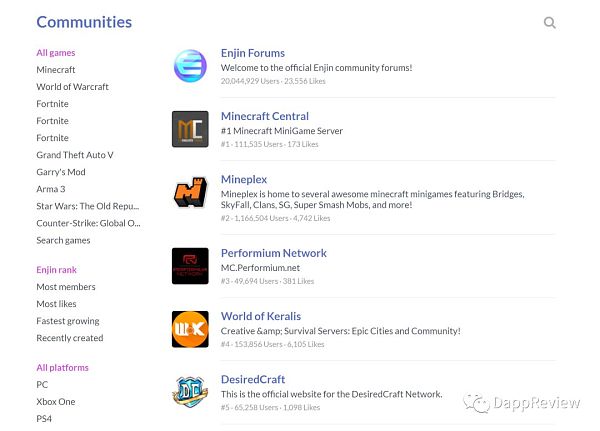
So Enjin created a Facebook-like platform that allows players to easily create a guild organization that invites other players to join by linking. Today, Enjin is already an online gaming community creation platform with 18.7 million registered users, 250,000 gaming community associations and approximately 60 million global visitors per month .
In October 2017, Enjin created Enjin Coin (abbreviated as ENJ) at Ethereum and officially entered the blockchain field. By selling funds to the public, the team raised 75,041 ETHs in just three months. According to the price of ETH at the time, the total value has exceeded $22 million. The issue price of ENJ is $0.03, and the current price has already reached $0.14.
In fact, the role of ENJ tokens is not just a tool for raising funds. From its core application scenarios, you can think of ENJ as a real-world material, such as steel. In daily life, steel can be used to make various items such as rails, cookware, nails, and art, and it can also be bought and sold in the raw material market.
ENJ is a kind of digital steel that can be bought and sold on the exchange, as well as weapons, props, digital artwork and everything else you can imagine. More intuitively, most of the ERC-721's NFT casting costs are almost zero, only the Gas Fee of the transaction, but in ERC-1155, Enjin encourages developers to use ENJ tokens as raw materials for NFT production (ie production costs) ) Casting .

Suppose you want to cast a sword based on ERC-1155 with 1000 ENJ, then in the generated NFT, it will contain tokens worth 1000 ENJ, which will be among the weapons. And as the original author of this sword you will get the following benefits:
-
The basic value of the sword comes from the raw materials, and the player can dissolve the sword at any time in exchange for 1000 ENJ.
-
If you cast 100 swords, this means that the sword is limited and you create the supply.
-
If it is a valuable supply, it will definitely generate market demand, and it depends on its use in the game and the willingness of the players to pay, which may make the sword's transaction value higher than the cost, that is, 1000 ENJ.
-
The player who bought the sword gains real ownership of it, and even if you no longer log in to the game, the smart contract will still protect the game props permanently at the owner's address.
-
Other players are free to trade the swords you create, and you don't need to know who is trading, you can collect a small amount of ENJ as a draw, and just count the money.
-
If you don't need this sword anymore, you can melt it and use it as an ENJ in other games.
-
The same sword can be used in multiple games, but there may be differences in the style of the game in different games. This is the legendary Enjin multiverse.

A total of 9.52 million ENJs have been locked in the ERC-1155 props that have been cast, worth about $1.33 million.
Enjin multiple universe
The game multi-cosmence that Enjin wants to build is a "collective" game world created by integrating the game assets of multiple games through a blockchain. In other words, Game Multiverse is a collaborative gaming project in which multiple game developers agree to use the same shared, decentralized database of some (all) in-game assets . This allows gamers to use specific blockchain assets in each game of the game's multiple universes.

Unlike the game multiverse in sci-fi movies (for example, OASIS among the number one players), they are centralized, all games and assets are controlled by an entity, and the Enjin blockchain game multi-cosm is decentralized. In-game assets in multiple universes are owned by gamers, and game developers only control the games they create . Blockchain technology is the only way to create a "real" game of multiple universes.
The meaning of ERC-1155
ENJ only meets the needs of players' production. In the transaction, the transaction cost problem will still cause problems for blockchain gamers. For example, if a player finds you wholesale 50 swords (the sword is actually an ERC-20 token), you need to complete 50 transactions to complete the transaction, which means 50 gas fees and 50 long waits.
Enjin thought of this, why can't the player trade 50 swords at once? So the ERC-1155 standard was born.
Let's first take a look at how ERC-1155 improves transaction efficiency. Under the existing token design logic, multiple steps are required to complete an atomic exchange—that is, using one token to trade another without a third-party intermediary.
Under the current rules, since each ERC-20 and ERC-721 token is in a separate contract, a total of 4 transactions are required to exchange the two tokens. For each additional token type, an additional "license" is required. (Approval)" operation. As shown below:

With some designs, the ERC-1155 can satisfy: no matter how many types of tokens are traded, simply bundle them in one contract and perform an approval step . As shown below:

You may also ask if there are 20 people who want to buy a sword and buy 5 for each person, then you still have to pay 20 gas fees for 20 trade confirmations! ERC-1155 continues to teach you how to be a person. Under this standard, you can send multiple items to one or more recipients at once using only one transaction, which can effectively reduce the cost of Gas and the congestion of Ethereum .
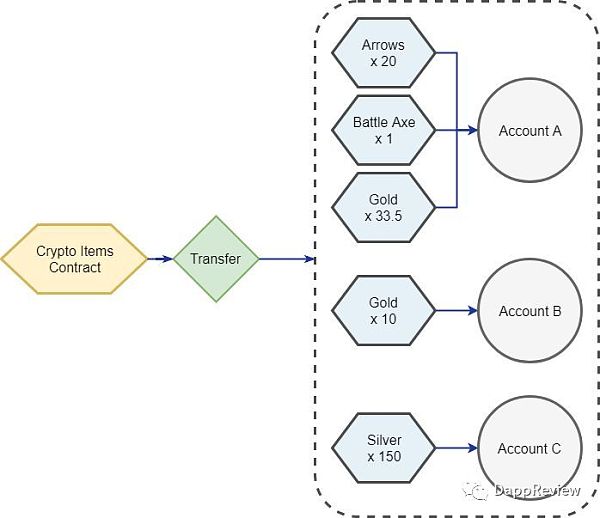
ERC-1155 is also known as the "multi-token standard" due to the integration of the respective features and advantages of ERC-20 and ERC-721. Compared with the two predecessors, ERC-1155 is undoubtedly the more standard for game assets, and more friendly to blockchain game developers. Developers can create thousands of different types of props for their games at a lower cost. These items can be non-homogeneous digital collections with separate IDs or homogenous tokens like ERC-20, as needed .
Witek Radomski issued a message on June 18 stating that ERC-1155 has entered its final state (Final Status), which means that there is no longer any change in RC-1155. As a new standard for casting homogenized tokens and non-homogeneous tokens, the Ethereum development community has been able to build applications based on ERC-1155.
In fact, many developers have already tasted the sweetness brought by ERC-1155:
Sandbox developer Ronan Sandford said he can use the ERC-1155 standard to cast more than 1,500 tokens in a single block while retaining real ownership of them.
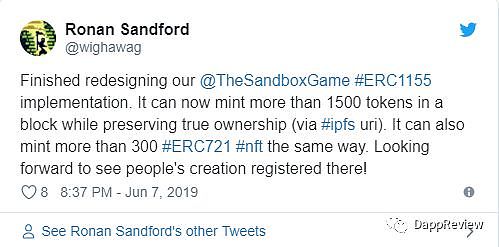
Phillip Games developer Phillippe Castonguay said that the ERC-1155 achieves 155 digital assets per second.

If you are a traditional game developer, blockchain white, it doesn't matter, you can try to build your own game on the Enjin platform. The development tools of the Enjin platform do not require any blockchain experience, and you can learn to run smart contracts at minimal cost.
Let's take a look at what is the Enjin platform.
Enjin platform and developer Spark Program Spark
Enjin platform
The Enjin platform is a blockchain PaaS (Platform as a Service) that allows developers to create and manage blockchain game assets — without having to build and maintain any blockchain infrastructure or write any blockchain related code. The main business of Enjin is to establish the connection between in-game assets and blockchain for developers without blockchain-related knowledge, and to help players trade their in-game assets . Developers use Enjin to make in-game items into ERC-1155 tokens, which players use to trade or experience these items in different games.

The picture above shows the location of the Enjin platform in the blockchain game, where players only deal with games and wallets. Using selling props, the player issues a request to sell the item to the game and agrees to the transaction in the wallet. The rest is done by Enjin and Ethereum. If the sale is successful, the player's item disappears and the corresponding gold coin is obtained.
Further , the composition of the Enjin platform can be further divided into Trusted Cloud, Platform API, and Wallet Daemon .
We can use a story to understand these three parts. One day you met an alien creature named Blockchain. Your voice was completely unreasonable. Then you suddenly found a Trusted Cloud universe translator, so you can start to communicate happily. But you find that the language of Blockchain is different from yours. Even if you understand each word, you don't understand what it says. You suddenly found a Platform API tool installed on your translator. It allows you to communicate in popular languages such as English and Java. Chatting and chatting, you find that Blockchain is like a group of people thinking, talking too fast, can't keep up, you can only get a Wallet Daemon installed on the translator, let him help you automatically For most of the information, you only need to focus on the conversations that interest you.
Simply speaking, the Trusted Cloud and Platform APIs allow developers to interact with blockchains in a popular programming language. The Wallet Daemon can automatically handle authorization requests on the chain, greatly improving the gaming experience.
Enjin will also offer multiple SDKs including the Unity Game Engine SDK, the Godot Game Engine SDK, and the Java & Minecraft SDK . These SDKs will cover a large number of developers and allow them to develop blockchain games quickly and easily through Enjin.
The Enjin platform hopes to create a non-zero-game world of games. In Enjin's eyes, each game is an economic system driven by the pure technology, enthusiasm and creativity of players and developers. As long as Enjin's blockchain game economy system thrives, the roles in the system will benefit.
Enjin Spark
Enjin's first wave of adopter programs last year provided excellent developers with an exclusive opportunity to access and build games on Testnet. Through this program, 20 innovative developers have built more than 40 projects, including games, apps and websites. These early adopters have achieved great success, with thousands of communities in their communities, and their crowdfunding and income combined to nearly $1 million before the game was officially launched.
Enjin Spark is the second wave of the Enjin Game Developer Program. Participants can access the Enjin platform through the main network in the early days, get consulting services from the Enjin professional team, and a series of powerful props that can be used in the Enjin multiverse.
Enjin game list
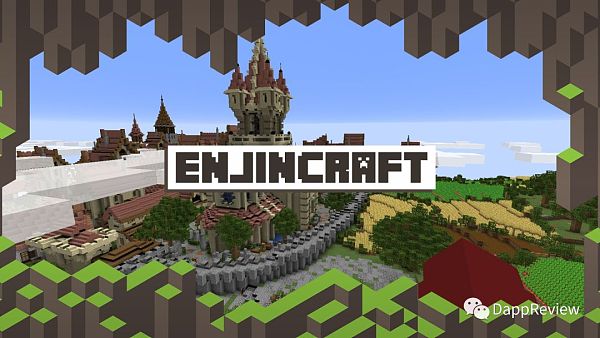
Enjin is launching the Testnet version of the open source Java SDK and the world's first blockchain-driven Minecraft server (EnjinCraft) . Two basic items, the Wooden Sword and the Wooden Shield, have been made into Enjin multi-cosm game assets. This means that every game developer is free to redesign the assets within these games in their game environment, so Wood Sword and Shield will provide you with unique items in each game.
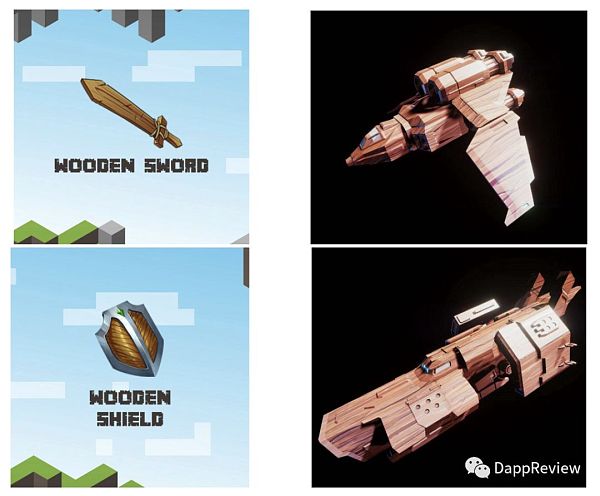
The two pictures on the left are the wooden swords and wooden shields in Minecraft, and the right fighters and defensive ships are the wooden swords and wooden shields in the 3D MMO sandbox game Space Misfits. Similarly, if a player has a fighter in Space Misfits, he will also have a wooden sword in Minecraft.
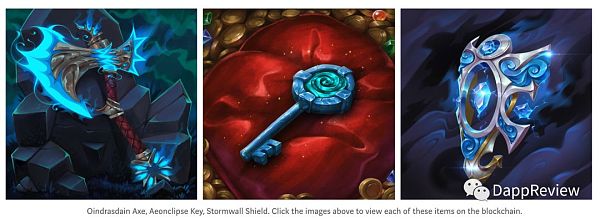
The above three items are examples of the basic props of the Enjin multi-cosm. Players can take them around and benefit from different games to make the game easier. Currently, the wooden sword and wooden shield in the Enjin multi-cosm have been successfully created on the EnjinCraft server and will soon be available in more than 30 other games .
The following is a list of Enjin multi-cosm games using these items and the launch time, which covers a wide range of mobile phones and computer platforms:
-
ReBounce: May! (Android & iOS)
-
Forgotten Artifacts: May! (PC)
-
Space Misfits: May! (PC)
-
Forest Knight: June 2019 (Android & iOS)
-
Bitcoin Hodler: July 2019 (Android & iOS)
-
AlterVerse (17 Games): July 2019 (PC)
-
Kriptomat: Q3 2019 (web platform)
-
9Lives Arena: Q3 2019 (PC)
-
Containment Corps: Q3 2019 (PC)
-
Cats in Mechs: Q4 2019 (Android & iOS)
-
Age of Rust: Q4 2019 (PC)
-
The Six Dragons: Q4 2019 (PC)
-
Nestables: Q4 2019 (Web GL, PC, Android & iOS)
-
Kingdom Karnage: Q4 2019 (Web GL, PC, Android & iOS)
-
Spirit Clash: Q4 2019 (PC, Android & iOS)
-
CryptoFights: Q4 2019 (Android)
-
A Turret's Life: Q1 2020 (PC)
Value to the player
Enjin's ultimate vision is to create Enjin multi-cosm that players have real ownership of game titles. There is no doubt that Enjin's multiple universes are a huge plus for players. Asset reuse allows players to greatly reduce the burden of "liver" in each game. You can experience the game as soon as possible and even get the benefits through the game . Now it can be understood as a huge game alliance. Some of the game assets in the game are absolutely owned by the players and can be reused and traded. If Tencent and NetEase also joined the alliance (which is of course impossible), Lu Ban in "Glory of the King" is a rare cat in "Catch the Demon Together", in the "Yin Yang Shi" into a demon knife, in " Stimulating the battlefield may be a decorative pendant, he can also be sold by the player, and the player who bought it also has the same rights as the seller. This reuse and absolute ownership will revolutionize the gaming world.
The foreseeable benefits are as follows:
-
Reducing the user's game cost (time, money), although it seems to conflict with the interests of game makers, developers can still design their own unique selling points in the game to make money, players save time to play a game, there will be more More time to experience other games , the total amount of payment in the multi-cosm of the game may not be reduced.
-
The flow brought by ecology, the game in multiple universes will form a game ecology, the players inside the ecology are more willing to play the game within the ecology is sure, so it will force other games to slowly enter this ecology to make the whole ecology more perfect.
-
Players will experience more interesting gameplay. After the multi-cosm is established, the game will definitely create more rules based on the new rules, such as the linkage of each game.
The problems and resistance encountered are also obvious:
-
For a game prop in a multi-cosm, is there a limit to the developer's use of props, or a reference standard? Otherwise, every developer wants to make the props more effective in their own games, to attract players who hold the props to give priority to their own game world experience, rather than other game worlds.
-
How are props correctly valued in the secondary market? Since the props are not only used in one game, if the game brought by the props in the game A is stronger, and the utility in the game B is weaker, then the game B is not played only for the game A, and the game B is not played only. In the perspective of the player of Game A, the value of the item may not be the same. In another extreme case, in game A and game B, the original item is not very effective, but a new game C comes out, which gives the item a very strong game attribute, which may cause the item value to be pulled straight. Rise. Uncertainty in valuations is bound to have an impact on the flow of props .
Conclusion:
Enjin's multiple universe is currently one of the coolest designs on the blockchain. It meets the needs of players, makes rational use of the characteristics of the blockchain and designs a solution including ERC-1155. . From the current trailer, the Enjin game may be the most playable in the chain tour, and hope that the game country it establishes can balance and maximize the interests of developers and players, and bring a benign development of the game ecology. Regarding whether NFT is a false proposition, and its own value, we will talk about it in the following articles.
Reference materials:
1. Enjin Coin White Paper (2017)
Https://enjincoin.io/enjincoin_whitepaper_en.pdf
2. ERC-1155: The Final Token Standard on Ethereum (2019)
Https://blog.enjincoin.io/erc-1155-the-final-token-standard-on-ethereum-a83fce9f5714
3. Introducing the Enjin Platform (2019)
Https://blog.enjincoin.io/introducing-the-enjin-platform-613e0930d631
4.Announcing Enjin Spark: The New Wave of Enjin Adopters (2019)
Https://blog.enjincoin.io/announcing-enjin-spark-the-new-wave-of-enjin-adopters-ce30f5571a66
We will continue to update Blocking; if you have any questions or suggestions, please contact us!
Was this article helpful?
93 out of 132 found this helpful
Related articles
- DApp's "AARRR" User Operation Strategy (on)
- The hardest core blockchain game
- IOST legend shocks on the line to achieve the perfect integration of blockchain and traditional online games | DApp Express
- Dapp warms up these 8 Dapp navigation to find out
- Chain Tea Interview: EOS Three Kingdoms: How was the chain tour that opened the first day of trading on the first day of trading?
- How to smash a BCH in a toilet, trash can or a grove? I laughed after reading it.
- Please pay attention to "App Governance". This is the Achilles of DApp.






